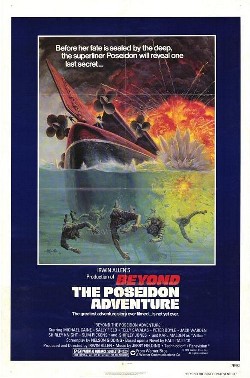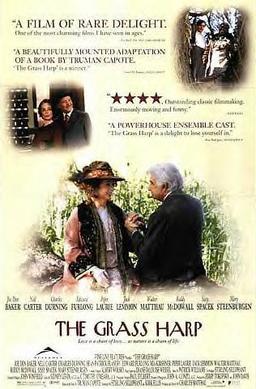
A miniature effect is a special effect created for motion pictures and television programs using scale models. Scale models are often combined with high speed photography or matte shots to make gravitational and other effects appear convincing to the viewer. The use of miniatures has largely been superseded by computer-generated imagery in contemporary cinema.

The Towering Inferno is a 1974 American disaster film directed by John Guillermin and produced by Irwin Allen, featuring an ensemble cast led by Paul Newman and Steve McQueen. It was adapted by Stirling Silliphant from the novels The Tower by Richard Martin Stern and The Glass Inferno by Thomas N. Scortia and Frank M. Robinson. In addition to McQueen and Newman, the cast includes William Holden, Faye Dunaway, Fred Astaire, Susan Blakely, Richard Chamberlain, O. J. Simpson, Robert Vaughn, Robert Wagner, Susan Flannery, Gregory Sierra, Dabney Coleman and Jennifer Jones in her final role.
The decade of the 1970s in film involved many significant developments in world cinema.

The Poseidon Adventure is a 1972 American disaster film directed by Ronald Neame, produced by Irwin Allen, and based on Paul Gallico's 1969 novel of the same name. It has an ensemble cast including five Oscar winners: Gene Hackman, Ernest Borgnine, Jack Albertson, Shelley Winters, and Red Buttons. The plot centers on the fictional SS Poseidon, an aging luxury liner on her final voyage from New York City to Athens, before it is scrapped. On New Year's Day, it is overturned by a tsunami. Passengers and crew are trapped inside, and a preacher attempts to lead a small group of survivors to safety.

Earthquake is a 1974 American ensemble disaster drama film directed and produced by Mark Robson and starring Charlton Heston and Ava Gardner. The plot concerns the struggle for survival after a catastrophic earthquake destroys most of the city of Los Angeles, California.
Irwin Allen was an American film and television producer and director, known for his work in science fiction, then later as the "Master of Disaster" for his work in the disaster film genre. His most successful productions were The Poseidon Adventure (1972) and The Towering Inferno (1974). He also created and produced the popular 1960s science-fiction television series Voyage to the Bottom of the Sea, Lost in Space, The Time Tunnel, and Land of the Giants.

Maureen Therese McGovern is an American singer and Broadway actress, well known for her renditions of the songs "The Morning After" from the 1972 film The Poseidon Adventure; "We May Never Love Like This Again" from The Towering Inferno in 1974; and her No. 1 Billboard adult contemporary hit "Different Worlds", the theme song from the television series Angie.

Airport 1975 is a 1974 American air disaster film and the first sequel to the successful 1970 film Airport. It was directed by Jack Smight, produced by William Frye, executive produced by Jennings Lang, and written by Don Ingalls. The film stars Charlton Heston, Karen Black, George Kennedy and Gloria Swanson – as a fictionalized version of herself – in her final film role.

Poseidon is a 2006 American action disaster film directed and co-produced by Wolfgang Petersen. It is the third film adaptation of Paul Gallico's 1969 novel The Poseidon Adventure, and a loose remake of the 1972 film. It stars Kurt Russell, Josh Lucas and Richard Dreyfuss with Emmy Rossum, Jacinda Barrett, Mike Vogel, Mía Maestro, Jimmy Bennett and Andre Braugher in supporting roles. It was produced and distributed by Warner Bros. in association with Virtual Studios. It had a simultaneous release in IMAX format. It was released on May 12, 2006, and it was criticized for its script but was praised for its visuals and was nominated at the 79th Academy Awards for Best Visual Effects. It grossed $181.7 million worldwide on a budget of $160 million; however, after the costs of promotion and distribution, Warner Bros. lost $70–80 million on the film, making it a box-office bomb as a result.

Beyond the Poseidon Adventure is a 1979 American disaster film and a sequel to The Poseidon Adventure (1972) directed by Irwin Allen and starring Michael Caine and Sally Field. It was a critical and commercial failure, and was the only Allen disaster film to receive no Academy Award nominations. Its box office receipts were only 20% of its estimated $10 million budget.
Sheila Mathews Allen was an American actress and producer.

When Time Ran Out... is a 1980 American disaster film directed by James Goldstone and starring Paul Newman, Jacqueline Bisset and William Holden. The supporting cast features James Franciscus, Ernest Borgnine, Red Buttons, Burgess Meredith, Valentina Cortese, Veronica Hamel, Pat Morita, Edward Albert and Barbara Carrera.
Harold Frank Kress was an American film editor with more than fifty feature film credits; he also directed several feature films in the early 1950s. He won the Academy Award for Best Film Editing for How the West Was Won (1962) and again for The Towering Inferno (1974), and was nominated for four additional films; he is among the film editors most recognized by the Academy of Motion Picture Arts & Sciences. He also worked publicly to increase the recognition of editing as a component of Hollywood filmmaking.

John Crawford was an American actor. He appeared in a 1961 episode of The Twilight Zone, called "A Hundred Yards Over the Rim", and in several Gunsmoke episodes. He had a key role in the 1975 film Night Moves, a crime thriller starring Gene Hackman. He also played the mayor of San Francisco in 1976's The Enforcer, the third Dirty Harry film featuring Clint Eastwood, as well as the Chief Engineer in Irwin Allen's classic 1972 box-office smash and disaster-film epic The Poseidon Adventure.

The Grass Harp is a 1995 American comedy-drama film based on the novella by Truman Capote. The screenplay, which was the final work of Oscar-winning screenwriter Stirling Silliphant, was adapted for the film. Directed by Charles Matthau, the film features a cast including Piper Laurie, Sissy Spacek, Walter Matthau, Jack Lemmon, Edward Furlong, and Nell Carter. Piper Laurie won the Best Supporting Actress award from the Southeastern Film Critics Association for her performance in the film.
Airport is a 1970s film series consisting of four airplane-themed disaster films: Airport, Airport 1975, Airport '77 and The Concorde... Airport '79. They are based on the 1968 novel Airport by Arthur Hailey. The four films grossed $387.5 million worldwide.
Adventures of the Queen is a 1975 American made-for-television drama film starring Robert Stack. It was made as a pilot for a potential TV series but screened as a stand-alone TV movie.
Aviation accidents and incidents, particularly civilian airplane crashes or incidents threatening a crash or requiring an emergency landing, are a common theme in fiction. Films centered on such incidents make up a substantial subset of the disaster film genre, and influence how other stories within the genre are told. Works in this genre encompass both fictional depictions of the incidents themselves, and depictions of consequences such as investigations, lawsuits, and the effect on the lives of persons involved. A subgenre, the "plane crash survival movie", involves characters placed in a dangerous environment by an initial airplane crash. Airplane crashes have been described as "the easy and obvious device" for dramatically incorporating an airplane into the plot of a film, and as "a Hollywood staple", with various levels of praise or criticism directed to the realism of specific depictions.










